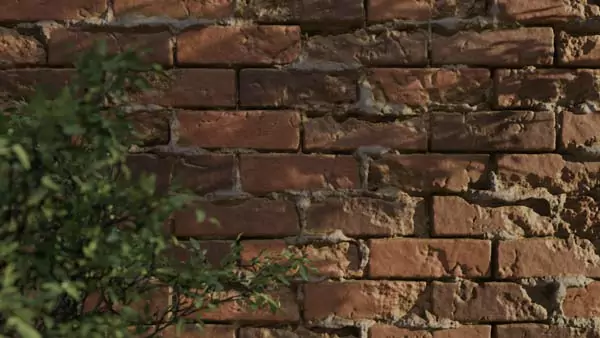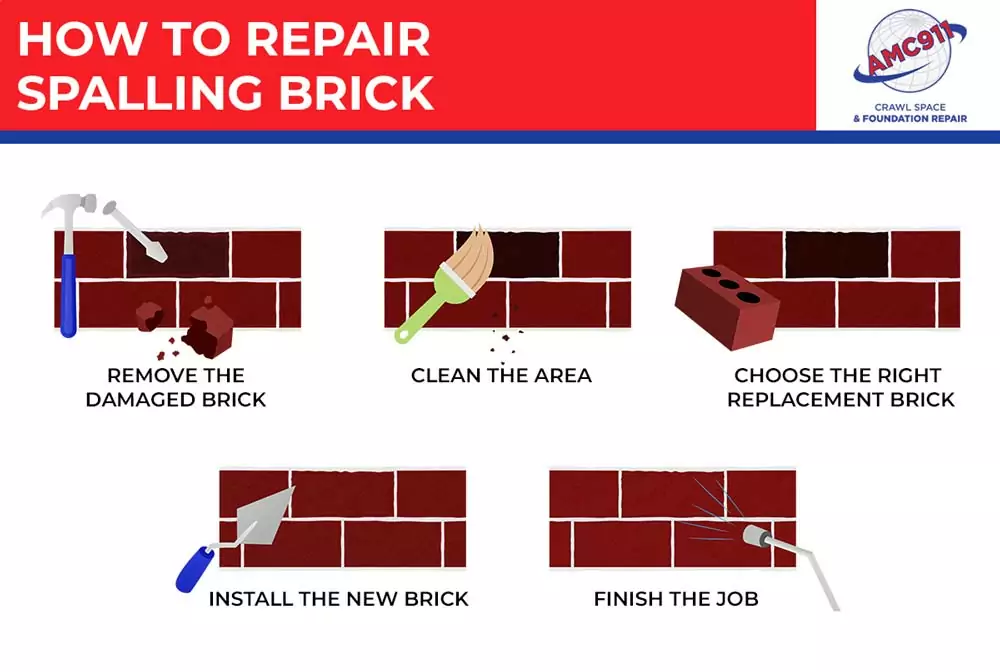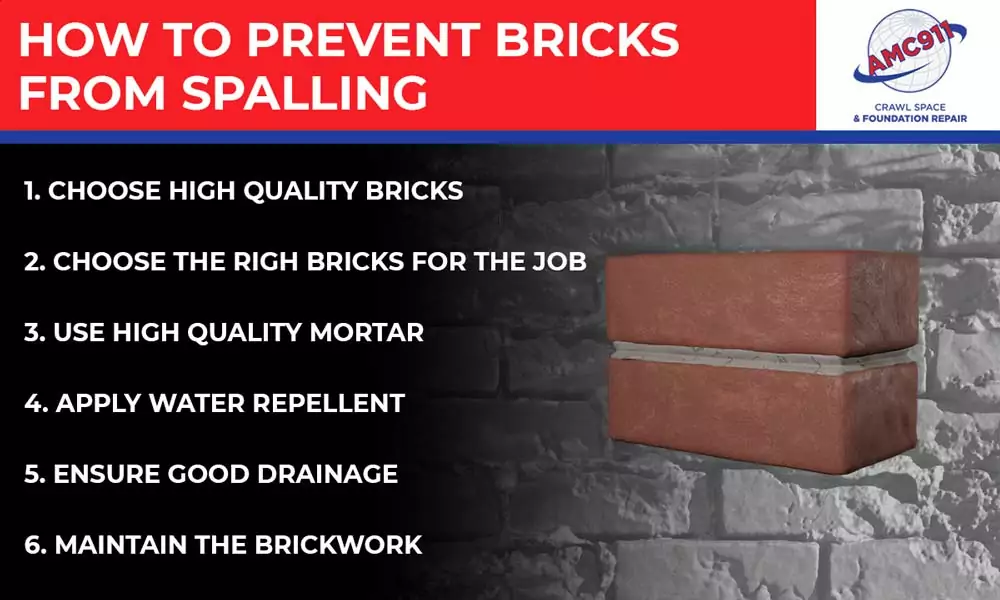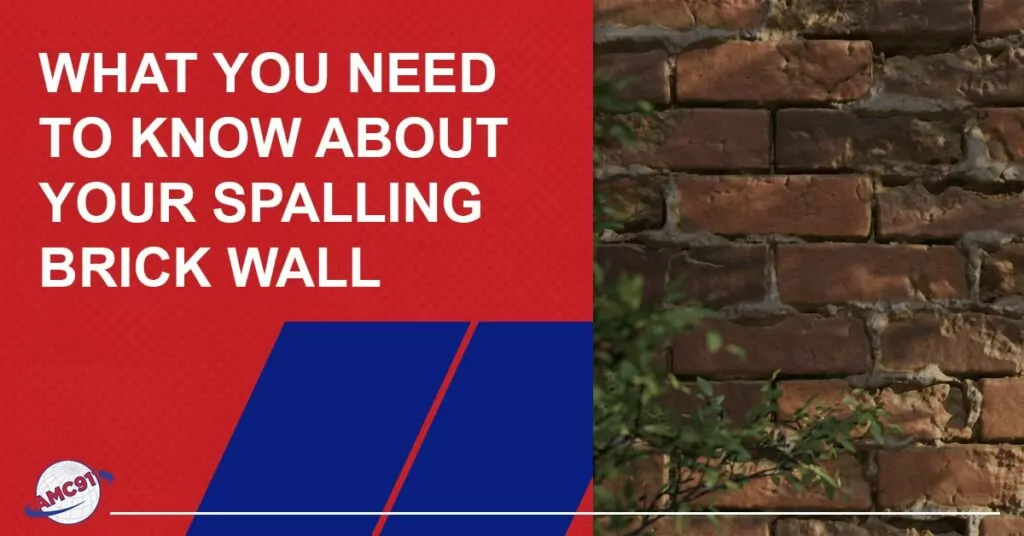Looking for information about spalling brick? If so, you’re in luck because masonry is our niche! In this article, we’ll review the causes of spalling brick, why spalling brick is a problem, repair options, and more.
What Is Spalling Brick?

Spalling brick is a common issue that occurs when the surface of a brick begins to flake or fall off. This is usually caused by exposure to the elements, moisture, and wear and tear over time.
The damage caused by spalling brick can vary from minor cosmetic issues to actual structural damage. Therefore, it’s best to address the problem promptly to prevent further damage.
Why Does Brick Spall?
Bricks are porous, and as such, they absorb water. When the water inside a brick freezes, it expands. This pressure pushing from the inside out can cause the brick to crack and pieces to flake off. This is called spalling.
Spalling brick is a common problem in areas with a cold climate or significant temperature fluctuations. This issue is mainly caused by the above-mentioned freeze-thaw cycle, which occurs when bricks absorb water that then freezes and thaws. Once the brick’s protective outer layer is damaged, water can penetrate deeper into the brick and cause further deterioration. This can lead to more severe spalling.
Spalling brick can also occur from improper installation or using the wrong mortar type.
It’s essential to address brick spalling as soon as possible, as it can lead to further damage and even compromise the structural integrity of a building eventually. Repairs may involve replacing damaged bricks or applying a protective coating to prevent further damage.
Why You Don’t Want Spalling Brick
Sure, spalling brick doesn’t look very nice. However, the underlying cause of spalling brick is the real concern. Typically, spalling is a sign the house is being attacked by moisture, which can lead to serious structural issues if left unchecked. Moisture can also lead to mold growth, which can pose a serious health risk to anyone living in the home.
How to Repair Spalling Brick
If the spalling is limited to just a few bricks and you have experience with DIY repairs around the home, you can probably handle this yourself. Here’s a step-by-step guide to help you get started:
- Remove the damaged brick – Start by chiseling away the spalling brick to remove it. This step can be a bit tricky, so it’s crucial to be patient and careful. Use a chisel and hammer to chip away the brick carefully, bit by bit, making sure to avoid damaging the surrounding bricks.
- Clean the area – Once the damaged brick is removed, clean the area thoroughly to remove any loose debris and dust. This step will help ensure the new brick adheres well to the spot.
- Choose the right replacement brick – It’s essential to select a replacement brick that matches the appearance of your brick. Look for the same texture, size, and color to ensure the new brick blends seamlessly with the surrounding bricks.
- Install the new brick – Place the new brick into the hole, making sure that it’s level with the surrounding bricks. Use mortar to secure the replacement brick firmly in place.
- Finish the job – After the mortar has dried, brush away any dust or debris from the area. If necessary, you can also use a breathable sealant to help prevent water infiltration and spalling in the future.

If you don’t have any experience with these types of DIY repairs, or if the brick spalling is spread out over a large area, you should contact a masonry repair professional.
For more information, see Can Brick Walls Be Repaired?
How to Prevent Bricks From Spalling
Fortunately, there are preventative measures you can take to help avoid brick spalling. These include the following:
- Choose high-quality bricks – High-quality bricks are better able to resist moisture ingress.
- Choose the right bricks for the job – Make sure the bricks are suitable for the intended application and environment. For example, bricks that are too soft may be prone to spalling in freezing temperatures.
- Use high-quality mortar – This will provide sufficient adhesion and flexibility. This will help prevent spalling caused by thermal expansion and contraction.
- Apply water repellent – Applying a breathable water repellent to the surface of the brick can help prevent moisture from penetrating the brick and causing damage.
- Ensure good drainage – Appropriate drainage around the brick wall will help prevent moisture ingress.
- Maintain the brickwork – Any cracks, gaps, or signs of damage should be repaired immediately before they become more extensive.

If you’re concerned about spalling brick on your property, contact AMC911 today to schedule an evaluation and receive a repair estimate.















